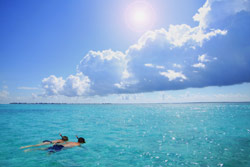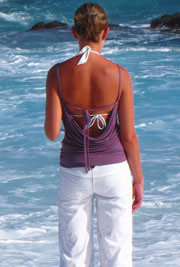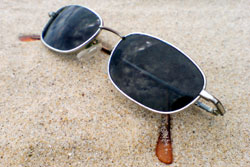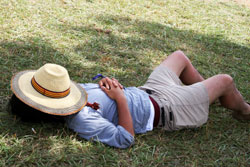- What is ultraviolet radiation?
- Sources of ultraviolet radiation
- Exposure to ultraviolet radiation and the risk of cancer
- Incidence of cancer associated with ultraviolet radiation
- Factors which increase the risk of cancers caused by ultraviolet radiation
- Preventing cancer by reducing exposure to ultraviolet radiation
What is ultraviolet radiation?
Ultraviolet (UV) radiation consists of high-energy rays which are invisible to the human eye, because they are outside of the colour spectrum which the human eye recognises (i.e. red, yellow, blue).
UV radiation comes mainly from the sun and is distinguished from other forms of radiation (e.g. visible radiation/light, infrared radiation/heat) by the length of its waves. UV rays are between 100-400 nanometres in length (compared to visible light rays which are >400 nanometres and x-rays which are <100 nanometres).
UV radiation can be further categorised as:1
- Vacuum UV or UV-C: wave length 100-200 nanometres;
- Short wave UV or UV-C: wave length 200-280 nanometres;
- Medium wave UV or UV-B: wave length 280-315 nanometres;
- Long wave UV or UV-A: wave length 315-400 nanometres.
Amongst these types of UV radiation, UV-B and UV-A are associated with sun exposure. UV-B is responsible for most of the adverse health effects of UV radiation exposure, however UV-A can also compromise health. The waves of UV-C radiation emanating from the sun are too short to penetrate the earth’s ozone layer, and thus do not create a health risk for humans. However, exposure to dangerous levels of artificial sources of UV-C may occur either occupationally or recreationally.
Sources of ultraviolet radiation
Sun

Solaria
Solaria are light chambers used for indoor cosmetic tanning. Like the sun’s rays, rays emitted by lights in a solarium include UV rays, and research has demonstrated that individuals who use solaria have a higher risk of developing skin cancers. There are currently no laws regulating the sale of solarium products in Australia.
Incandescent lamps
Incandescent lamps, including commonly used fluorescent lamps, as well as specialty lamps, emit generally low levels of ultraviolet radiation. The UV radiation generated by a standard fluorescent bulb is insufficient to penetrate its glass or plastic covering. However other specialty lamps (e.g. germicidal lamps) emit UV radiation far more efficiently and thus create a health risk. Germicidal lamps used in medical and other environments for disinfection purposes emit UVC rays very efficiently. Metal halide lamps, also commonly found in medical environments, emit large amounts of UV radiation, as do Xenon lamps (used in the investigation of patients with sun-induced skin diseases) and quartz (or tungsten) halogen lamps (used for specialised lighting).
Arc discharge
Electric welding arcs emit UV radiation at hazardous levels, and so individuals operating electric welding arcs will become exposed to UV radiation if appropriate protective clothing is not worn. Individuals working in the direct environment of an arc welder (e.g. in the same factory) as well as onlookers or passers by, are also at risk.
For more information, see How Arc Discharge Affects Health.
Lasers
Lasers are most commonly employed in the medical industry for diagnostic and treatment purposes and many lasers emit UV radiation (e.g. the argon fluoride laser, used for corneal refractive surgery emits UV-C rays). This means that individuals using or being treated with lasers can be exposed to dangerous levels of UV radiation and the use of UV emitting lasers in Australia is regulated by AS/NZS2211.1:1996.
Exposure to ultraviolet radiation and the risk of cancer
Despite being invisible, UV rays can be very dangerous to the human body if over-exposure occurs. When UV rays come into contact with a human, they are absorbed by the cells of the skin. Melanin which causes pigmentation in the skin (i.e. causes the skin to be a lighter or darker colour) assists in the absorption process, and individuals with higher levels of melanin (i.e. individuals with more darkly pigmented skin) are able to absorb the sun’s rays more effectively.
Absorption of the sun’s rays by the skin results in the production of reactive biomolecules or free radicals, which typically cause cell damage, (e.g. damage to the DNA strand in the cell’s nucleus). Cells naturally repair much of the damage caused by UV exposure, and, until such repairs have been undertaken, the cells are prevented from dividing and replicating as new cells. The process in which a single cell divides to create two replica cells is known as mitosis and is regulated by P53 proteins.
The P53 proteins (encoded by P53 genes), usually block damaged cells from undergoing mitosis, as these cells would replicate new, damaged cells. However, if the gene structure of the cell has been damaged, P53 proteins will be inactivated, enabling damaged cells to commence mitosis. Unregulated division and replication of cells with UV-induced mutations will then occur, resulting in skin cancer.
There are two types of skin cancer:
- Cutaneous Malignant Melanoma: These are highly malignant skin cancers which metastasise to distant organs over short periods of time. While non-melanoma skin cancers can also be malignant, melanoma tend to metastasise more quickly and they thus present a greater health risk;
- Non-melanoma: Non melanoma skin cancers originate from skin cells in the epidermis and represent around 90% of all skin cancers.
Non-melanoma skin cancers can also be further classified as:
- Squamous cell carcinoma: Squamous skin cells are the cells that comprise the outer layer of the skin’s epidermal layer. Squamous cell carcinoma of the skin is cancer which begins in the skin’s squamous cells;
- Basal cell carcinoma: Basal skin cells are cells of the skin’s epidermis (i.e. the layer of cells which form the skin’s surface). They form the second layer of the epidermis, directly below squamous cells. Basal cell carcinoma is cancer originating from the basal cell layer. These are the most common types of skin cancers, which are 4-8 times more common than squamous cell carcinoma, depending on latitude.
In addition to skin cancer, exposure to UV radiation also increases the risk of squamous cell carcinoma of the eye and other eye diseases.
Incidence of cancer associated with ultraviolet radiation

Non-melanoma skin cancers
As incident cases of non-melanoma skin cancer are not routinely collected by cancer registries in Australia, information regarding their incidence comes from population based surveys. While this information is not as reliable as information collected by cancer registries, it nonetheless shows that non-melanoma skin cancers are extremely common. Some 70% of men will develop at least one non-melanoma skin cancer by the time they reach 70 years of age, while 58% of women will develop at least on non-melanoma skin cancer.
In terms of the number of non-melanoma skin cancers which occur each year, one recent survey reported that an estimated 374,000 cases of non-melanoma skin cancer are treated in Australia annually. This equates to 1.8% of the population receiving treatment for skin cancer each year. Another study estimated that in 2002, 256,000 incident cases of basal cell carcinoma and 118,000 cases of squamous cell carcinoma were diagnosed and treated.
While non-melanoma skin cancers are usually responsive to treatment, diagnosis and treatment of these cancers consumes the greatest proportion of health funds of any cancer in Australia. In the 2000-01 financial year some $264 million or 9% of total health funds for cancer, were spent on diagnosing and treating non-melanoma skin cancers.
Despite this, non-melanoma skin cancers continue to contribute significantly to mortality. In 2002, 270 men and 137 women died in Australia as a result of non-melanoma skin cancers. This equates to a mortality rate of 1.6 per 100,000 for men and 0.5 per 100,000 for women.
Melanoma skin cancers
Excluding non-melanoma skin cancers, melanoma was the third most commonly diagnosed cancer in both men and women in 2005 (following breast and colorectal/bowel cancer for women and prostate and colorectal/bowel cancer for men). In that year 10,014 people were diagnosed with melanoma (5,705 men and 4,309 women) and 1,273 individuals (862 men and 411 women) died as a result of melanoma. This equates to a 1 in 24 chance of developing melanoma by age 75 for men, and a 1 in 33 chance for women.
The melanoma associated mortality rate increased consistently between 1931-1985 by an average of 6% per year for men and 3% per year for women. Amongst men, the melanoma associated mortality rate continues to rise (although less rapidly at an annual rate of increase of 0.7%). Mortality as a result of melanoma in women, did however decline by 0.4% each year 1991-2005.
Factors which increase the risk of cancers caused by ultraviolet radiation
While the exact levels of UV radiation exposure necessary to increase the risk of sun cancer is unclear, it appears that both cumulative (i.e. lifetime) and episodic exposure to the sun is important. Episodes of sun exposure that result in sunburn are of particular importance. It also appears that sun exposure during childhood is more damaging than during adulthood, as the children’s skin contains less melanin than that of adults. The risk of cancer associated with sun exposure during childhood and adulthood also appears to differ.
The factors associated with an increased risk of skin cancer are:
- History of childhood sunburn: Individuals who were ever sunburnt as children are 1.8 times more likely to develop melanoma skin cancer as adults, compared to individuals who did not experience sunburn as children.
- Childhood sun exposure: Childhood sun exposure is an important determinant of the risk of basal cell carcinoma.
- Recreational sun exposure: Recreational sun exposure refers to time spent in the sun for recreational purposes (e.g. sports, picnics). It is associated with an increased risk of basal cell carcinoma. Recreational exposure is also the strongest predictor of melanoma skin cancer.
- Lifetime sun exposure: Lifetime sun exposure Is the total amount of sun exposure an individual has received in their lifetime. It is the second most important risk factor for melanoma skin cancers.
- Occupational UV exposure: Occupational UV exposure is exposure to the sunlight or other sources of UV radiation (e.g. welding arcs) during work, because the individual works in an outdoor industry (e.g. agriculture, sport or construction) or one in which specialist equipment emitting UV radiation (e.g. lasers used in medical settings) are used. It is associated with an increased risk of squamous cell carcinoma.
- History of adult sunburn: Individuals who have ever experienced sunburn as an adult are 1.5 times more likely to develop melanoma skin cancers, than individuals who have not experienced sunburn as adults.
- Being male: In Australia, for all types of skin cancer, there is a higher incidence amongst men than women. For example approximately 2,093 per 100,000 males develop basal cell carcinoma and 1,053 per 100,000 males develop squamous cell carcinoma each year, compared to 1,456 per 100,000 and 615 per 100,000 females respectively. Men are also more likely to die as a result of skin cancers.
- Having melano-compromised or fair skin: Melano-compromised skin is skin with low levels of melanin which typically burns and freckles easily when exposed to the sun. Some 90% of all skin cancers appear in individuals with melano-compromised skin and thus skin cancer is rare in individuals of non-European origin (i.e. non-Caucasians).
- Geographic location: Individuals who live closest to the equator (where levels of UV radiation are highest) are most likely to develop non-melanoma skin cancers. For example the rate of both squamous and basal cell skin cancers is some three times higher in latitudes closest to the equator. In Australia, these cancers are more common in northerly states (i.e. Queensland and Northern Territory) compared to southerly states (e.g. Victoria, New South Wales).
Preventing cancer by reducing exposure to ultraviolet radiation
Sunlight

The best known of Australia’s skin cancer prevention campaigns to date is the “Slip, Slop, Slap” campaign, developed by the Victorian Cancer Council in the 1980s. This campaign used the catchy “Slip, Slop, Slap” slogan, to inform individuals to “slip on a shirt, slop on sunscreen and slap on a hat”. These messages still form the basis of skin cancer prevention campaigns in Australia and are well known amongst Australians and internationally. However, despite Australians’ almost universal knowledge of “Slip, Slop, Slap”, skin cancer remains the most commonly diagnosed cancer in the country and a significant cause of death.
The myth that tanned skin is not only healthy but also more attractive than non-tanned skin, remains extremely pervasive in Australia. This message is reinforced to most individuals on a daily basis in the form of mass media advertising and programming which overwhelming pictures of tanned models or actors/actresses in skimpy clothing which displays the skin. However exposing the skin to sufficient quantities of sunlight to enable a tan to develop, equates to exposing skin to enough UV radiation to increase the risk of developing skin cancer. In short, tanning the skin, either in sunlight or a solarium creates a risk of sun cancer.
There are a number of key methods of protecting the skin from cancer by reducing sun exposure, which should be implemented for protection when sun exposure occurs. In Australia, state and territory Departments of Education and Training require schools provide practical and effective measure to protect children from sun exposure whilst at school and develop policies outlining how they will do that. State and territory cancer councils provide practical recommendations to assist schools in implementing such measures.
Measure which can be taken to protect from UV exposure are further discussed below.
Applying sunscreen when exposed to sunlight
Sunscreen is a chemical known as a photosensitiser which absorbs or scatters UV radiation before it can be absorbed by the skin. It is recommended for use on areas of the body which cannot be conveniently covered by clothing (e.g. face and hands), but wherever possible, individuals should use protective clothing instead of sunscreen (e.g. to protect the arms and legs). It is important that individuals apply ample quantities of sunscreen when they are going to be exposed to the sun. A sunscreen with a high Sun Protection Factor (SPF) of 30+ offers the highest level of protection and should be used instead of sunscreens offering lower SPF. Sunscreen should be applied at least 30 minutes before exposure to sunlight and reapplied every two hours while in the sun. Australian school should make sunscreen available to teachers and students when they are exposed to sunlight. Practitioners should be aware however that current evidence suggests that the use of sunscreen is protective in relation to squamous cell carcinoma of the skin, but may not protect an individual from basal cell carcinoma of the skin or melanoma. It is also important that sunscreen is not seen as an excuse to stay in the sun for longer periods of time, but rather is applied when sun exposure cannot be avoided.
Wear protective clothing when exposed to sunlight
The fabric in clothing provides a UV absorbent barrier between the sun and the skin, and thus protects the skin’s exposure to UV radiation. Most fabrics provide an SPF of at least 10, and 85% of fabrics provide an SPF of >20. While different fabrics provide different levels of protection, the primary determining factor is the fabric’s fibre content and fabrics with a higher fibre coverage provide better UV protection. Individuals should wear protective clothing on the legs and arms each time they are exposed to sunlight for extended periods of time. In Australia employers are required to provide workers with appropriate protective clothing (as well as hats and sunglasses) whilst exposed to sunlight in the workplace, and it is the employee’s responsibility to ensure that such clothing is worn. For Australian schools, it is recommended that uniforms be designed in a manner to provide adequate sun protection.
Wear a broad brimmed hat when exposed to sunlight
A hat with a broad brim protects an individual from sun exposure by blocking UV radiation and providing shade to the face. The broader the hat brim, the better the protection and a hat with a 7cm brim will reduce the face’s (including the ears’ and eyes’) exposure to sun by a factor of five. School are encouraged to implement policies which prevent children from playing in the sun if they are not wearing a broad-brimmed hat and to further encourage teachers and visiting parents to wear such hats.
Wear sunglasses when exposed to sunlight
It is important that individuals wear sunglasses which meet the Australian standards, every time they go into the sun. Sunglasses provide a barrier between UV radiation and the eyes and thus prevent the harmful effects of UV radiation. The Australian Cancer Council recommends individuals wear sunglasses with wrap around (i.e. side) protection which comply with Australian Standard AS/ANZ 1067:2003. Sunglasses which meet the Australian Standard should be labelled with AS/ANZ 1607:2003 and a category number. In addition, the lenses of the sunglasses should offer a high level of UV protection, and be labelled UV400 or EPF9 or 10.
Avoid the sun between 10am and 2pm
Levels of ultraviolet radiation in sunlight are highest in the middle of the day (i.e. between 10am-2pm) and thus exposure to sunlight is most dangerous at this time. It is most important to limit exposure to sunlight at this time, by staying indoors, wearing protective clothing or using shaded areas. Schools are encouraged to limit outdoor activities during this period.
Protect against UV exposure even when it’s cloudy
While individuals are not exposed to the same amount of heat on a cloudy day, UV rays (if in smaller quantities) are able to penetrate clouds and thus wearing appropriate protective clothing and accessories is also important on cloudy days. Individuals should be equally conscious of the risk of UV exposure on a cloudy day, even though the usual warning sign of over-exposure to sunlight i.e. heat) is largely absent on a cloudy day.
Utilise shade

Training and education
Training and education are important aspects of protecting outdoor workers and school children. In outdoor workplaces, training regarding the risks of UV exposure for various skin types and the preventative measures which can be taken, should be provided to all new employees on employment and periodically thereafter. In schools, programs designed to educate about the risk of UV exposure should focus on promoting safe behaviour and educating about the lifetime risk of sun exposure.
Artificial sources of UV
There are also numerous measures which should be taken to protect individuals from exposure to artificial sources of UV radiation, which are discussed further below.
Engineering controls
There are numerous engineering controls which can be implemented to provide protection against artificial UV rays. In particular it is important that structures and barriers made of UV protective materials are erected to enclose areas where UV radiation is emitted. These may be further protected by interlocks (i.e. locks which automatically switch off power to the source of UV radiation when the lock is opened). Surfaces in such enclosures should be coated with material which does not reflect UV radiation.
Administrative controls
Administrative controls include training workers and limiting their access to areas in which a dangerous level of UV radiation is emitted, and are key protective measures in the workplace. All workers should be familiar with areas which present a danger. Such areas should be surrounded by appropriate signs which workers are trained to recognise. Access to areas where dangerous levels of UV radiation are present should be restricted to appropriately trained and clothed personnel, for limited periods of time.
Personal protective clothing
Where engineering and administrative controls cannot be applied to prevent UV exposure, it is important that individuals are provided with appropriate protective clothing to reduce their UV exposure. The areas of the body most at risk are those not typically covered by work clothing (i.e. hands, face, neck and eyes). Gloves to protect the hands should be provided, and manufactured from a material with low UV ray transmission. Face shields and protective eye goggles, made from materials which absorb UV radiation should be provided to employees who will be exposed to UV radiation. In Australia, protective eyewear to prevent indoor exposure to artificial sources of UV radiation must comply with the Australian Standard AS/NZS1337:1992- Eye Protectors for Industrial Applications.
References
-
Vecchio, P. Hietanen, M. Stuck, B.E. et al. Protecting Workers from Ultraviolet Radiation. International Labour Organisation and World Health Organisation, 2007. Available from: [URL Link]
- The Cancer Council Australia. “Preventable Risk Factors- Ultraviolet Radiation” in National Cancer Prevention Policy 2007-09. 2007. Available from: [URL Link]
- Gallagher, R.P. Spinelli, J.J. Lee, T.K. Tanning beds, Sunlamps and risk of cutaneous malignant melanoma. Cancer Epidemiol Biomarkers Preven. 2005, 14(3):562-6.
- Australian Radiation Protection and Nuclear Safety Agency. Radiation Protection Standard: Occupational Exposure to Ultraviolet Radiation [online]. 2006. Available from: [URL Link]
- World Health Organisation. WHO Information Series of School Health, Document 7: Sun Protection: an essential element of health promoting schools [online]. WHO/UNESCO, 2002. Available from: [URL Link]
- Australian Institute of Health and Welfare and Australian Association of Cancer Registries. Cancer in Australia 2001 [online]. 2004. Available from: [URL Link]
- National Cancer Control Initiative. The 2002 national non-melanoma skin cancer survey: a report by the NCCI Non-melanoma skin cancer working group [online]. Ed. M.P. Staples, 2003. Available from: [URL Link]
- Staples, M.P. Elwood, M. Burton, R.C. et al. Non-melanoma skin cancer in Australia: the 2002 National Survey and trends since 1985. MJA. 2006,184:6-10.
- McDermid, I. Cancer Incidence Projections Australia 2002-2011 [online]. Australian Institute of Health and Welfare, Australian Association of Cancer Registries and National Cancer Strategies Group, 2005. Available from: [URL Link]
- Australian Bureau of Statistics. Causes of death, Australia 2005 [online]. 2007. Available from: [URL Link]
- Whiteman, D.C. Whiteman, C.A. Green, A.C. Childhood Sun Exposure as a Risk Factor for Melanoma: a systematic review of epidemiological studies. Cancer Causes Control, 2001, 12(1):69-82.
- World Health Organisation. Global Solar UV Index: A Practical Guide [online]. World Health Organization. Available from: [URL Link]
- The Cancer Council Queensland, Schools Sun Smart Policy Guidelines, 2007. Available from: [PDF File]
- International Agency for Research on Cancer. Do Sunscreens Prevent Skin Cancer [online]. 2000. Available from: [URL Link]
- van der Pols, J.C. Williams, G.M. Pandeya, N. Prolonged Prevention of Squamous Cell Carcinoma of the Skin by Regular Sunscreen Use. Cancer Epidemiol Biomarkers Prev. 2006, 15(12):2546-8.
- Australian Cancer Council. Eye Protection from Ultraviolet Radiation [online]. 2006. Available from: [PDF File]
- Australian Radiation Protection and Nuclear Safety Agency. UV Resource Guide- Australian Sunglass and Safety Glass Standard [online]. 2006, available from: [URL Link]
All content and media on the HealthEngine Blog is created and published online for informational purposes only. It is not intended to be a substitute for professional medical advice and should not be relied on as health or personal advice. Always seek the guidance of your doctor or other qualified health professional with any questions you may have regarding your health or a medical condition. Never disregard the advice of a medical professional, or delay in seeking it because of something you have read on this Website. If you think you may have a medical emergency, call your doctor, go to the nearest hospital emergency department, or call the emergency services immediately.







